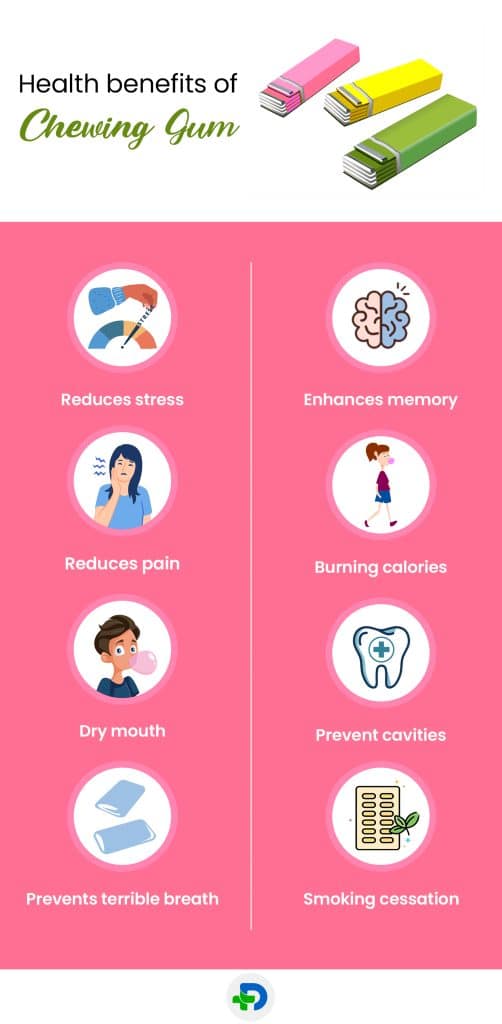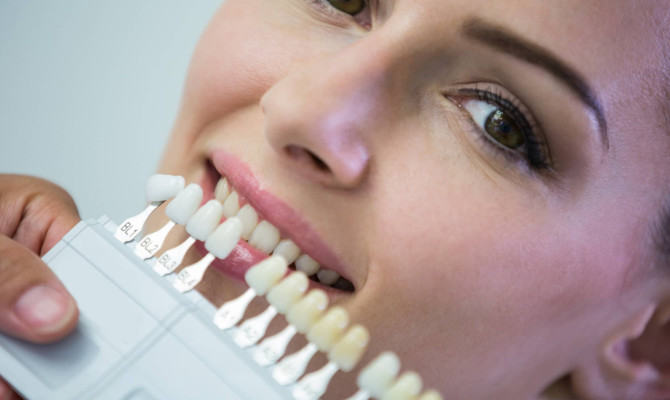All about chewing gums

- Chewing Gum
- 16 Aug 2023
Overview
What is chewing gum?
Gum, or chewing gum, is a soft, sticky substance that is chewed but not swallowed. Gum chewing habit has existed in various forms for thousands of years. Today, however, the gum is manufactured synthetically and sold in bulk. Due to its resin, polymer, and plasticizer components’ physical-chemical properties, which also add to its elastic-plastic, sticky, and chewy characteristics, it has a texture reminiscent of rubber. This article highlights numerous health advantages, hazards, backgrounds, and components used.

History of chewing gum
- The word “mastication” apparently originated from mastic, which the ancient Greeks appeared to have chewed on.1Overview| Researched based study from Ada.org
- The Aztecs and Mayans were the first to have made gum-like substances using chicle, a natural tree gum, and reaped its benefits.
- John B. Curtis developed and distributed the State of Maine Pure Spruce Gum in 1848, which was the first chewing gum made for sale.
- John Colgan, a pharmacist from Louisville, Kentucky, created the first flavor-flavored chewing gum in the 1860s.
- On December 28, 1869, William Semple submitted a patent application for chewing gum with the serial number 98,304. However, Amos Tyler of Toledo, Ohio, patented it on July 27, 1869. 2Overview| Researched based study from Nlm.nih.gov
Types
Types of chewing gum
Chewing gums can be various types, namely
Sugared chewing gums
- Chewing gums with sugar frequently contains sucrose.
- Sucrose and other fermentable carbohydrates can be utilized by oral bacteria such as Streptococcus mutans and lactobacillus species to cause enamel demineralization and tooth cavities.1Types| Researched based study from Ada.org
Sugar-free chewing gums
- The ADA Seal of Acceptance is only given to sugar-free chewing gums.
- Instead of sugar, high-intensity sweeteners like acesulfame-K, stevia, aspartame, saccharin, neotame, or sucralose are used to sweeten gum.
- Other sugar alcohols used to sweeten gum include erythritol, iso-malt, maltitol, mannitol, sorbitol, and xylitol.
- These sweeteners unlike sugar do not produce tooth cavity because the cavity producing bacteria only digest them slowly or not at all.
Medicated chewing gum
- There are currently medicated chewing gums for pain relief, quitting smoking, travel sickness, and breath refreshing.
- Additionally, many chewing gum options are currently designed to prevent cavities, treat xerostomia, and provide extra vitamins and minerals.3Types| Researched based study from Pharmatutor.org
Ingredients
Ingredients present in chewing gum
While recipes might differ between brands, the following essential components are present in all chewing gums
- Gum base – the rubbery, indigestible component that gives gum a chewy texture.
- Elastomers or Resin are generally included to make gum stronger and keep it together.
- Adjuvants – talc or calcium carbonate are fillers that are added to give gum its texture.
- Preservatives – the shelf life is increased by adding preservatives. The most preferred option is a substance known as butylated hydroxytoluene (BHT).
- Plasticizers or softeners – are substances that help gum retain moisture and avoid drying out. Waxes and vegetable oils are examples of them.4Ingredients| Researched based study from Nlm.nih.gov
- Sweeteners – include corn syrup, beet sugar, cane sugar, etc. Sugarless gums contain artificial sweeteners like aspartame or sugar alcohols like xylitol.3Ingredients| Researched based study from Pharmatutor.org
- Natural or artificial flavors – added to gum to give it the appropriate taste. Citrus oil, peppermint oil, and more examples are given.
- Coloring agent – include pigments, natural food colors, and dyes appropriate for food, medicine, and cosmetics use.3Ingredients| Researched based study from Pharmatutor.org
Every ingredient used in the production of chewing gum must be food-grade and suitable for human consumption.
Health benefits

Health benefits of chewing gum
Gum chewing has a variety of health advantages, such as
Reduces stress
- Regular gum chewing may be linked to a reduction in a person’s stress.5Health benefits| Researched based study from Nlm.nih.gov
Enhances memory
- It has been discovered that elderly participants who chewed gum performed better when asked to recollect past events.6Health benefits| Researched based study from Nlm.nih.gov
Reduces pain
- Active chewing may help with pain relief or stress reduction, but sustained oral habits raise the risk of exhaustion, pain, or TMJ disorders.7Health benefits| Researched based study from Nlm.nih.gov
Burning calories
- Chewing gum while walking may help maintain weight and stop the population’s obesity caused by age-related weight increases.8Health benefits| Researched based study from Nlm.nih.gov
Dry mouth
- A decreased saliva flow frequently contributes to dry mouth and poor breath. A person’s mouth produces more saliva when they chew sugar-free gum, which could lessen the signs of dry mouth and poor breath.9Health benefits| Researched based study from Dentalhealth.org
Prevent cavities
- Using sugar-free chewing gum right after meals lowers cavities. The stimulation of saliva while chewing, the absence of sucrose, and the inability of bacteria to convert polyols into acids all contribute to the reported reduction in caries.10Health benefits| Researched based study from Nlm.nih.gov
Prevents terrible breath
- It has been demonstrated that gums with active ingredients that target the bacteria that produce bad breath lower the number of volatile sulfur compounds (VSCs) in the mouth, thus preventing bad breath.11Health benefits| Researched based study from Nlm.nih.gov
Reduces acid reflux
- After a meal, chewing sugar-free gum for thirty minutes can assist with acid reflux.12Health benefits| Researched based study from Nlm.nih.gov
Smoking cessation
- Nicotine gums are used as smoking cessation aid. It functions by giving the body nicotine to lessen the withdrawal symptoms of quitting smoking and by substituting it for oral action to lessen the desire to smoke.13Health benefits| Researched based study from Medlineplus.gov
Precautions
Precautions one should take while consuming chewing gum
Gum chewing is generally regarded as safe. However, the following should be remembered
- The gum may contain potentially dangerous and debatable components such as calcium casein peptone, butylated hydroxytoluene (BHT), aspartame, and titanium dioxide, among other things. 14Precautions| Researched based study from Xylitol.org However, the quantities are often much smaller than those considered harmful.
- For sugar-free gums that pose less risk to the health of teeth, look for the American Dental Association (ADA) certification seal. According to studies, using these gums when you have cavities is safe and won’t worsen them.
- Chewing gums are intended to be chewed and spit out rather than swallowed because human bodies cannot digest them.
- Children under the age of five should not be given chewing gum because they cannot tell the difference between gum and candy and pose a choking threat.15Precautions| Researched based study from Kidshealth.org
- People with jaw problems should avoid chewing gums. One shouldn’t chew gum if they have TMJ problems or begin to feel any jaw popping, clicking, or pain. Visit the dentist if these problems are appearing recently.
- One should never chew gum excessively because doing so can cause jaw issues, even in healthy people. Gum chewing should be limited to no more than 15 minutes each day.
- Gum chewing should not be used as a substitute for routine brushing, flossing, or dental cleanings, even if it has the ADA seal.
- By brushing and flossing daily, people can maintain good oral health.
Side effects
Side effects of chewing gum
Excessive gum chewing may have a few adverse effects including
- Headache.
- Jaw pain.
- Tooth fracture.
- Ear pain.
- Temporomandibular joint (TMJ) pain
- Clicking of one or both TMJs.16Side effects| Researched based study from Clevelandclinic.org
- Cavities on teeth. (In case of chewing sugary gums)
- Mouth irritation seen in nicotine gum chewing.16Side effects| Researched based study from Clevelandclinic.org
Takeaway
Key takeaways
Most manufacturers of chewing gum refer to their specific mixture as their gum base instead of disclosing the exact ingredients that go into it. It has been determined that chewing gum’s constituents are safe for human consumption. Chewing may offer unexpected health benefits. Chewing a stick or two of gum in between meals is a good idea if a person does not already have a problem with their jaw joint (TMJ). Stick to sugar-free gum if one must chew gum. Sugary gums should not be consumed.
Any feedback on this article?
 This Articles content was accurate
This Articles content was accurate Very Informative Article
Very Informative Article I have a question or a comment
I have a question or a comment
 This article contains inaccurate content
This article contains inaccurate content This article was not helpful
This article was not helpful I have a question or a comment
I have a question or a comment
We appreciate your helpful feedback!
Checkout our social pages
References
-
American Dental Association
Chewing Gum | History
-
About Ohio History Central
William F. Semple | History
-
Pharma Tutor
Medicated Chewing Gum: A Review | Types
-
National Library of Medicine
Medicated chewing gum, a novel drug delivery system | Ingredients
-
National Library of Medicine
Chewing gum and stress reduction | Health Benefits
-
National Library of Medicine
Chewing Maintains Hippocampus-Dependent Cognitive Function | Health benefits
-
National Library of Medicine
Chew the Pain Away: Oral Habits to Cope with Pain and Stress and to Stimulate Cognition | Health benefits
-
National Library of Medicine
Gum chewing while walking increases fat oxidation and energy expenditure | Health benefits
-
Oral Health Foundation
Sugar free chewing gum | Health benefits
-
National Library of Medicine
SUGAR-FREE CHEWING GUM AND DENTAL CARIES – A SYSTEMATIC REVIEW | Health benefits
-
National Library of Medicine
Chewing Gums as a Drug Delivery Approach for Oral Health | Health benefits
-
National Library of Medicine
The effect of chewing sugar-free gum on gastro-esophageal reflux | Health benefits
-
Medline Plus
Nicotine Gum | Health benefits
-
Xylitol
What’s Really in Your Gum – 5 Terrifying Ingredients | Precautions
-
The Nemours Foundation
What Happens to Swallowed Gum? | Precautions
-
Cleveland Clinic
Is Chewing Gum Bad for You? | Side effects



































